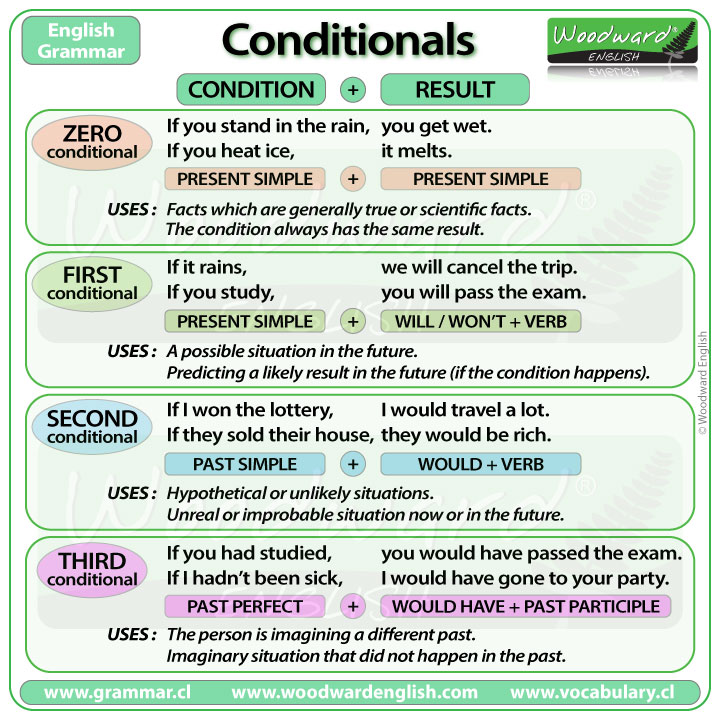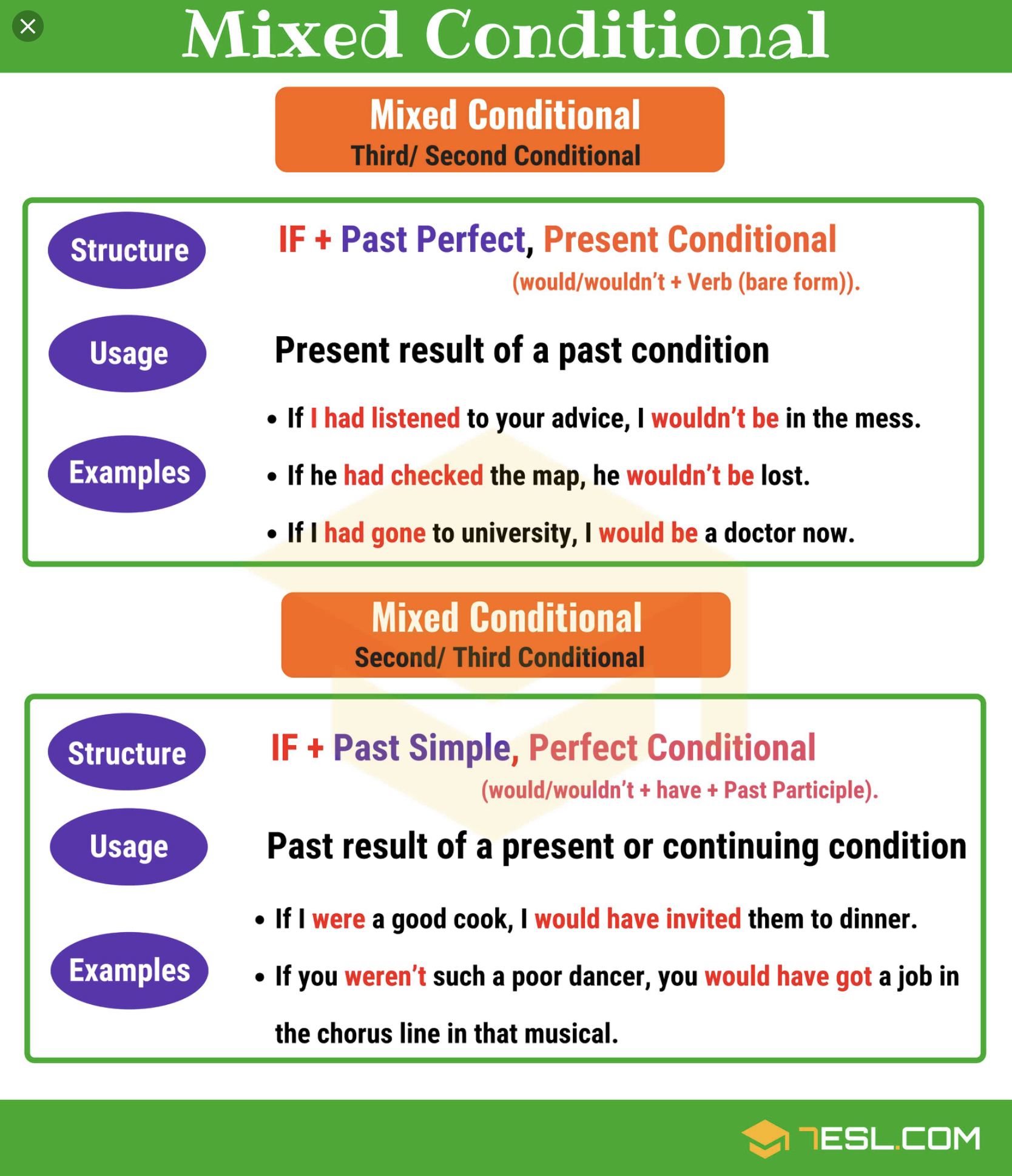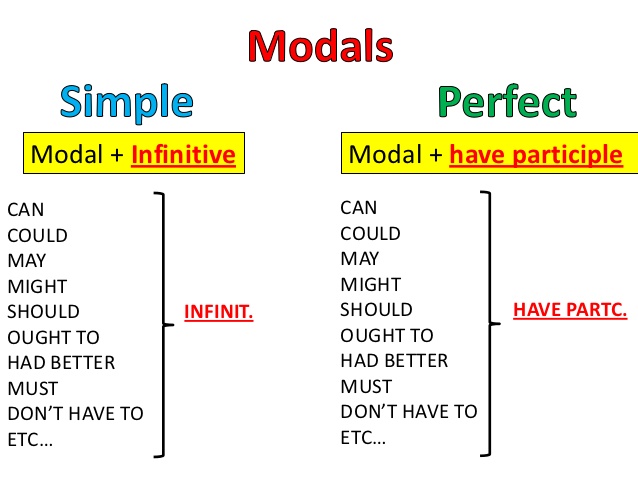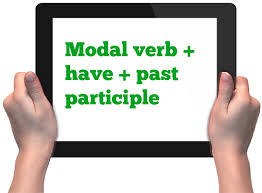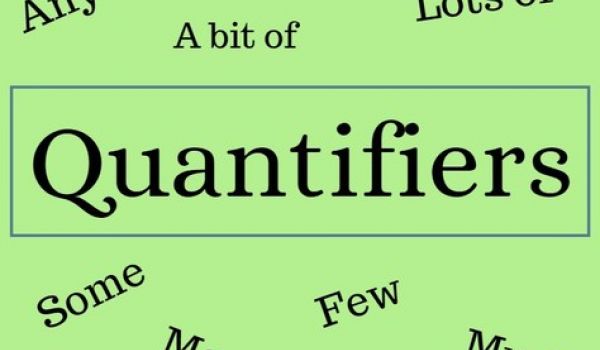Conditional Sentences / If-Clauses Type I, II and III
1. Form
type if-clause main clause I Simple Present will-future or (Modal + infinitive) II Simple Past would + infinitive * III Past Perfect would + have + past participle *
| type | if-clause | main clause |
|---|---|---|
| I | Simple Present | will-future or (Modal + infinitive) |
| II | Simple Past | would + infinitive * |
| III | Past Perfect | would + have + past participle * |
2. Examples (if-clause at the beginning)
type if clause main clause I If I study, I will pass the exam. II If I studied, I would pass the exam. III If I had studied, I would have passed the exam.
| type | if clause | main clause |
|---|---|---|
| I | If I study, | I will pass the exam. |
| II | If I studied, | I would pass the exam. |
| III | If I had studied, | I would have passed the exam. |
3. Examples (if-clause at the end)
type main clause if-clause I I will pass the exam if I study. II I would pass the exam if I studied. III I would have passed the exam if I had studied.
| type | main clause | if-clause |
|---|---|---|
| I | I will pass the exam | if I study. |
| II | I would pass the exam | if I studied. |
| III | I would have passed the exam | if I had studied. |
4. Examples (affirmative and negative sentences)
type Examples long forms short/contracted forms I + If I study, I will pass the exam. If I study, I'll pass the exam. - If I study, I will not fail the exam.
If I do not study, I will fail the exam.
If I study, I won't fail the exam.
If I don't study, I'll fail the exam. II + If I studied, I would pass the exam. If I studied, I'd pass the exam. - If I studied, I would not fail the exam.
If I did not study, I would fail the exam. If I studied, I wouldn't fail the exam.
If I didn't study, I'd fail the exam. III + If I had studied, I would have passed the exam. If I'd studied, I'd have passed the exam. - If I had studied, I would not have failed the exam.
If I had not studied, I would have failed the exam. If I'd studied, I wouldn't have failed the exam.
If I hadn't studied, I'd have failed the exam.
* We can substitute could or might for would (should, may or must are sometimes possible, too).
- I would pass the exam.
- I could pass the exam.
- I might pass the exam.
- I may pass the exam.
- I should pass the exam.
- I must pass the exam
WAS or WERE?
| type | Examples | ||
|---|---|---|---|
| long forms | short/contracted forms | ||
| I | + | If I study, I will pass the exam. | If I study, I'll pass the exam. |
| - | If I study, I will not fail the exam. If I do not study, I will fail the exam. | If I study, I won't fail the exam. If I don't study, I'll fail the exam. | |
| II | + | If I studied, I would pass the exam. | If I studied, I'd pass the exam. |
| - | If I studied, I would not fail the exam. If I did not study, I would fail the exam. | If I studied, I wouldn't fail the exam. If I didn't study, I'd fail the exam. | |
| III | + | If I had studied, I would have passed the exam. | If I'd studied, I'd have passed the exam. |
| - | If I had studied, I would not have failed the exam. If I had not studied, I would have failed the exam. | If I'd studied, I wouldn't have failed the exam. If I hadn't studied, I'd have failed the exam. | |
* We can substitute could or might for would (should, may or must are sometimes possible, too).
- I would pass the exam.
- I could pass the exam.
- I might pass the exam.
- I may pass the exam.
- I should pass the exam.
- I must pass the exam
WAS or WERE?
ESTILO DIRECTO vs ESTILO INDIRECTO
Cuando queremos repetir las palabras textuales de lo que otra persona ha dicho, utilizamos el estilo directo. Es facilísimo de reconocer porque siempre va entre comillas (“…”).- “I am visiting my grandma today.” Mary said.
El estilo indirecto se diferencia del directo, entre otros aspectos, en que no lleva comillas y no reproduce exactamente las mismas palabras del emisor.- Mary said she was visiting her grandma that day.
- “I am visiting my grandma today.” Mary said.
- Mary said she was visiting her grandma that day.
Cambios
Si comparamos los ejemplos de arriba, veremos que la información es la misma, pero se han producido ciertos cambios en su estructura.
“I am visiting my grandma today.” Mary said.
Mary said she was visiting her grandma that day.
El emisor es Mary. Por lo tanto, es ella la que está visitando a sus abuelos (ni a los míos, ni a los vuestros…a los suyos).
¿Y cuándo los visita? Pues ese día en concreto, porque yo no he dicho cuándo me dijo Mary eso. Igual fue hoy mismo como hace tres meses, con lo cual, ese today ya no es válido. Y si el adverbio ya no es hoy, el tiempo tampoco será presente continuo.
Cambios que se producen en el Reported Speech:
- Los pronombres
- Los adverbios
- Los demostrativos
- Los verbos
Los pronombres
Obviamente, debemos tener presente quién es el emisor y a quién se refieren esos pronombres (personales o posesivos). Normalmente los pronombres cambian a 3ª persona del singular o plural, salvo si el hablante se refiere a sus propias palabras.
Personas:
I /me/my/mine————- he/she/his/hersyou/your/yours ———– him/his/her/herswe/us /our/ours/you/your/yours ————- they/their/theirs
Aquí te dejo la tabla de todos los pronombres para que quede más clarito:
PronombreSujeto PronombreObjeto AdjetivoPosesivo Pronombre Posesivo I Me My Mine Myself You You Your Yours Yourself He Him His His Himself She Her Her Hers Herself It It Its (Its) Itself We Us Our Ours Ourselves You You Your Yours Yourselves They Them Their Theirs Themselves One One One’s ———– Oneself
Los adverbios
O expresiones de tiempo y de lugar. Si en estilo directo decimos “now“, en estilo indirecto diremos: “Then” o “At that moment“. Veamos más cambios:- Now ——— then// at that moment
- Today ——- that day
- Tonight ———— that night
- Yesterday — the day before// the previous day
- Tomorrow —- the next day// the following day
- The next day/month/year… — the following day/month/year…
- Last week——————- the week before
- Ago ——————————- before//previously
- Here —————————— there
Los demostrativos- This ———– that
- These——— those
- Los pronombres
- Los adverbios
- Los demostrativos
- Los verbos
I /me/my/mine————- he/she/his/hers
Pronombre Sujeto | PronombreObjeto | AdjetivoPosesivo | Pronombre Posesivo | |
| I | Me | My | Mine | Myself |
| You | You | Your | Yours | Yourself |
| He | Him | His | His | Himself |
| She | Her | Her | Hers | Herself |
| It | It | Its | (Its) | Itself |
| We | Us | Our | Ours | Ourselves |
| You | You | Your | Yours | Yourselves |
| They | Them | Their | Theirs | Themselves |
| One | One | One’s | ———– | Oneself |
- Now ——— then// at that moment
- Today ——- that day
- Tonight ———— that night
- Yesterday — the day before// the previous day
- Tomorrow —- the next day// the following day
- The next day/month/year… — the following day/month/year…
- Last week——————- the week before
- Ago ——————————- before//previously
- Here —————————— there
- This ———– that
- These——— those
Los verbos
Debéis recordar que todo lo que se dice en estilo directo, cambiará al pasado en el indirecto. Siempre iremos un paso hacia atrás en el tiempo. De este modo:
Si está en ……..Present …………….pasará a ………….Pasado- Present Simple……..……………………………Past Simple
- Present Continuous…………………………. Past Continuous
- Present Perfect……………………………………Past Perfect
**NOTA: Si lo que se dice es algo que aún continúa, no es necesario cambiar el tiempo de presente a pasado.
Si está en ……..Past …………….pasará a ………….Past perfect- Past Simple……..………………………….Past Perfect
- Past Continuous…………………………Past Perfect Continuos
- Past Perfect…………………………………Past Perfect
Si está en ……..Futuro …………….pasará a su forma de pasado**→ Am/is/are going to…………Was/Were going to
Si es un ……..modal …………….pasará a su forma de pasadoPara tener una ayudita a mano, os recomiendo que os imprimáis este cuadro/resumen de todos los tiempos verbales en inglés.
Una vez tenemos estos cambios controlados, podemos pasar a los tipos de enunciados: afirmaciones, preguntas, sugerencias y órdenes.
- Present Simple……..……………………………Past Simple
- Present Continuous…………………………. Past Continuous
- Present Perfect……………………………………Past Perfect
- Past Simple……..………………………….Past Perfect
- Past Continuous…………………………Past Perfect Continuos
- Past Perfect…………………………………Past Perfect
Afirmaciones
- Ejemplo: “I feel ill this morning” Pam said.
Pam said (that) she felt ill that morning.
(“that” podemos omitirlo)
- Ejemplo: “I feel ill this morning” Pam said.
Preguntas
Existen dos tipos de preguntas.1. WH-question words (preguntas con Why, What, Who, How…)- Ejemplo: “What is your name?” she asked me.
She asked me WHAT my name was.
**Recordad que en el estilo indirecto ya no es una pregunta y, por lo tanto, tenemos que seguir el orden lógico de la oración: Suj + Verb
WHAT my name was
2. YES/NO Questions (preguntas que se responden afirmativa o negativamente)- Ejemplo: “Are you hungry now?” I asked them
I asked them if they were hungry then.
- Ejemplo: “What is your name?” she asked me.
- Ejemplo: “Are you hungry now?” I asked them
Sugerencias
Hay dos formas de sugerir algo.- “Let’s buy a pizza” he said–He suggested buying a pizza.
- “Why don’t we go to the cinema?” she said–He suggested that we go to the cinema.
- “Let’s buy a pizza” he said–He suggested buying a pizza.
- “Why don’t we go to the cinema?” she said–He suggested that we go to the cinema.
Órdenes (imperativo)
¡¡No lo confundas con el presente!!! El imperativo empieza directamente con un verbo.
Los reporting verbs más frecuentes para dar órdenes y peticiones son: order (ordenar), warn (advertir), ask (preguntar), advise (aconsejar) y forbid (prohibir).- Ejemplo: “Eat all you food now!” the mother asked the little boy.
The mother told the little boy TO EAT all his food then.- “Don’t smoke!” the doctor told me.
The doctor told me NOT TO SMOKE.
Y ahora, el más difícil todavía… ¡Mezclados! Intentad hacerlos sin mirar la chuletilla:

MODAL VERBS : CAN / COULD / MUST / SHOULD
CAN = Poder, saber hacer algoI can speak English = Sé hablar inglésI can't speak German = No sé hablar alemánCan you hear me? = ¿Puedes oírme?
COULD = Podía, podría, pudo (Es el pasado de “can”)He could run very fast = Él podía correr muy rápidoHe couldn't play football last week = Él no pudo jugar al fútbol la semana pasadaCould you open the door? = ¿ Podrías abrir la puerta?
MUST = Deber , tener queEn afirmativa e interrogativa expresa obligación.They must go now = Ellos deben irse ya.Must we do the homework? = ¿Debemos hacer los deberes?
En negativa expresa prohibiciónYou mustn't eat in class = No debes comer en clase
SHOULD = Debería, deberías, etcEn afirmativa se usa para dar y pedir consejos o para hacer sugerencias.You should pay attention = Deberías atender
En negativa se utiliza para dar a entender que algo no nos parece buena idea.You shouldn't smoke = No deberías fumar
CARACTERÍSTICAS:1 – Utilizan la misma forma para todas las personas.2 – Van seguidos de infinitivo sin “to”.3 – En negativa añaden “not” o su forma breve al verbo.4 – En interrogativa invertimos el sujeto y el verbo
MODAL PERFECTSClick on the image below and read this useful information that explains it in full detail.
GERUNDS AND INFINITIVES
There are certain verbs in English that are usually followed by an infinitive or gerund. Their meaning changes depending on the form being used. Let's have a look at them!
More info + practice

Click to read about it
- Ejemplo: “Eat all you food now!” the mother asked the little boy.
- “Don’t smoke!” the doctor told me.

MODAL VERBS : CAN / COULD / MUST / SHOULD
MODAL PERFECTS
Click on the image below and read this useful information that explains it in full detail.
| ||||||
TO-infinitive or gerund: FORGET, REMEMBER, REGRET, GO ON, STOP, TRY
After these verbs, a to-infinitive refers to the future, while a gerund expresses an earlier action, relative to the time of the verb in the main clause:
Don't forget to meet Mr Moriarty at 10 o'clock this morning. (You should meet Mr Moriarty at 10 o'clock this morning.)I'll never forget meeting her for the first time. (I'll never forget when I met her for the first time.)
Did you remember to buy tea? (Did you remember that you should buy tea?)I don't remember ever visiting this museum. (I don't remember that I have ever visited this museum.)
We regret to inform you that your application has been rejected. (We are sorry we have to inform you that your application has been rejected.) I regret spending so much money last night. (I am sorry that I spent so much money last night.)
Whichever page you're on, go on to read the next chapter. (Continue with the next chapter.)Go on reading the article. (Continue reading the article.)
We stopped to drink a cup of coffee. (We stopped in order to drink a cup of coffee.)I stopped smoking years ago. (I gave up smoking years ago.)
I tried to reach her at work, but the line was busy. (I made an attempt to reach her at work.)Why didn't you try calling her on her mobile? (Why didn't you call her on her mobile to see if you could reach her?)

OPINION ESSAY
Find examples of Opinion Essays HERE!
Don't forget to meet Mr Moriarty at 10 o'clock this morning. (You should meet Mr Moriarty at 10 o'clock this morning.)I'll never forget meeting her for the first time. (I'll never forget when I met her for the first time.)
Did you remember to buy tea? (Did you remember that you should buy tea?)I don't remember ever visiting this museum. (I don't remember that I have ever visited this museum.)
We regret to inform you that your application has been rejected. (We are sorry we have to inform you that your application has been rejected.) I regret spending so much money last night. (I am sorry that I spent so much money last night.)
Whichever page you're on, go on to read the next chapter. (Continue with the next chapter.)Go on reading the article. (Continue reading the article.)
We stopped to drink a cup of coffee. (We stopped in order to drink a cup of coffee.)I stopped smoking years ago. (I gave up smoking years ago.)
I tried to reach her at work, but the line was busy. (I made an attempt to reach her at work.)Why didn't you try calling her on her mobile? (Why didn't you call her on her mobile to see if you could reach her?)

QUANTIFIERS
What are quantifiers?
A quantifier is a word or phrase which is used before a noun to indicate the amount or quantity:
'Some', 'many', 'a lot of' and 'a few' are examples of quantifiers.
Quantifiers can be used with both countable and uncountable nouns. Find more info below.
FUTURE CONTINUOUS
Formación
El "future continuous" está compuesto por dos elementos:
el "simple future" del verbo 'to be' + el "present participle" (raíz+ing) del verbo principal
| Sujeto | +"simple future" de "to be" | +"present participle" del verbo principal |
|---|---|---|
| You | will be | watching |
| I | will be | staying |
To stay, "future continuous"
| Afirmativa | Negativa | Interrogativa | Negativa interrogativa |
|---|---|---|---|
| I will be staying. | I won't be staying. | Will I be staying? | Won't I be staying? |
| You will be staying. | You won't be staying. | Will you be staying? | Won't you be staying? |
| He will be staying. | He won't be staying. | Will he be staying? | Won't he be staying? |
| She will be staying. | She won't be staying. | Will she be staying? | Won't she be staying? |
| It will be staying. | It won't be staying. | Will it be staying? | Won't it be staying? |
| We will be staying. | We won't be staying. | Will we be staying? | Won't we be staying? |
| They will be staying. | They won't be staying. | Will they be staying? | Won't they be staying? |
Funciones
El "future continuous" hace referencia a una acción o evento inacabados que seguirán ocurriendo con posterioridad al momento presente. El "future continuous" se emplea con una considerable variedad de propósitos.
El "future continuous" puede utilizarse para proyectarnos hacia el futuro.
Ejemplos
- This time next week I will be sun-bathing in Bali.
- By Christmas I will be skiing like a pro.
- Just think, next Monday you will be working in your new job.
El "future continuous" puede utilizarse para realizar predicciones o suposiciones sobre eventos futuros.
Ejemplos
- He'll be coming to the meeting, I expect.
- I guess you'll be feeling thirsty after working in the sun.
- You'll be missing the sunshine once you're back in England.
En forma interrogativa, el "future continuous" sirve para pedir educadamente información sobre el futuro.
Ejemplos
- Will you be bringing your friend to the pub tonight?
- Will Jim be coming with us?
- Will she be going to the party tonight?
- Will I be sleeping in this room?
El "future continuous" puede utilizarse para hacer referencia a eventos de cierta duración que creemos que se desarrollarán en el futuro.
Ejemplos
- I'll be seeing Jim at the conference next week.
- When he is in Australia he will be staying with friends.
- I'll be eating with Jane this evening so I can tell her.
En combinación con el término "still", el "future continuous" hace referencia a eventos que ya están ocurriendo ahora y que suponemos que se prolongarán en el futuro.
Ejemplos
- In an hour I'll still be ironing my clothes.
- Tomorrow he'll still be suffering from his cold.
- Next year will she still be wearing a size six?
- Won't stock prices still be falling in the morning?
- Unfortunately, sea levels will still be rising in 20 years.
FUTURE PERFECT SIMPLE
Formación
El "future perfect" está compuesto por dos elementos:
el "simple future" del verbo "to have" (will have) + el "past participle" del verbo principal
| Sujeto | + will have | + "past participle" del verbo principal |
|---|---|---|
| He | will have | finished. |
| I | will have | finished. |
To arrive, "future perfect"
| Afirmativa | Negativa | Interrogativa | Negativa interrogativa |
|---|---|---|---|
| I will have arrived | I won't have arrived | Will I have arrived? | Won't I have arrived? |
| You will have arrived | You won't have arrived | Will you have arrived? | Won't you have arrived? |
| He will have arrived | He won't have arrived | Will he have arrived? | Won't he have arrived? |
| We will have arrived | We won't have arrived | Will we have arrived? | Won't we have arrived? |
| They will have arrived | They won't have arrived | Will they have arrived? | Won't they have arrived? |
Funciones
El "future perfect" se refiere a una acción que se completará en el futuro. Cuando empleamos este tiempo verbal, estamos proyectándonos hacia el futuro y echando la vista atrás, hacia una acción concluida en algún momento posterior al presente. La mayoría de las veces, se emplea con expresiones temporales.
Ejemplos
- I will have been here for six months on June 23rd.
- By the time you read this I will have left.
- You will have finished your report by this time next week.
- Won't they have arrived by 5:00?
- Will you have eaten when I pick you up?
FUTURE PERFECT CONTINUOUS
Formación
El "future perfect continuous" está compuesto por dos elementos:
el "future perfect" del verbo "to be" (will have been) + el "present participle" del verbo principal (raíz + ing)
| Sujeto | + will have been | + "present participle" del verbo principal |
|---|---|---|
| He | will have been | playing. |
| I | will have been | playing. |
To live, "future perfect continuous"
| Afirmativa | Negativa | Interrogativa | Negativa interrogativa |
|---|---|---|---|
| I will have been living | I won't have been living | Will I have been living? | Won't I have been living? |
| You will have been living | You won't have been living | Will you have been living? | Won't you have been living? |
| He will have been living | He won't have been living | Will he have been living? | Won't he have been living? |
| We will have been living | We won't have been living | Will we have been living? | Won't we have been living? |
| They will have been living | They won't have been living | Will they have been living? | Won't they have been living? |
Funciones
Al igual que el "future perfect", empleamos este tiempo verbal para proyectarnos hacia el futuro y echar la vista atrás. El "future perfect continuous" se refiere a eventos o acciones inacabadas, situadas entre el momento presente y un tiempo futuro. La mayoría de las veces se acompaña de expresiones temporales.
Ejemplos
- I will have been waiting here for three hours by six o'clock.
- By 2030 I will have been living in London for sixteen years.
- When I finish this course, I will have been learning English for twenty years.
- Next year I will have been working here for four years.
- When I come at 6:00, will you have been practising long?
WRITING: An Article
As I have seen that some of you find it difficult to differentiate between "Article" and "Opinion Essay", I'm attaching a link with information about it.
DEFINING AND NON-DEFINING RELATIVE CLAUSES
We use non-defining relative clauses to give extra information about the person or thing. It is not necessary information. We don’t need it to understand who or what is being referred to.
 |
| Read +info |
PAST SIMPLE - PAST PERFECT
Para progresar en el idioma es esencial contar con una buena base. Por ello, te invitamos a que revises con nosotros los tiempos verbales que se utilizan en inglés para hablar de eventos pasados. Hoy nos centraremos en las diferencias entre el past simple y el past perfect.
Uno de los retos más difíciles a la hora de aprender el inglés es diferenciar y saber usar los tiempos verbales. Por esta razón, hoy queremos explicarte cómo utilizar correctamente el past simple y el past perfect.
Diferencias entre past simple y past perfect
Usar el past simple y past perfect de forma correcta no es tan difícil, solo es necesario tener en mente algunas reglas y practicar mucho. A continuación te lo explicamos:
Past simple
Usamos el past simple para expresar una serie de eventos que tuvieron lugar en un momento concreto en el pasado y han finalizado. En español equivaldría al pasado simple o pretérito perfecto simple.
Para construir el past simple en inglés, se añade –ed a la raíz del verbo si este es regular y si no usamos su forma irregular. El auxiliar did se usa para formar frases negativas o interrogativas.
Algunos ejemplos:
- Elena flew to France last week.
- She studied German in school.
- He woke up, got dressed, took the bus and went to school.
Algunos ejemplos con la forma negativa e interrogativa:
- I didn’t enjoy dinner last night.
- Did you enjoy dinner last night?
Past perfect
Este tiempo en inglés se corresponde con el pretérito pluscuamperfecto del español. Normalmente usamos el past perfect para, en una oración con dos acciones pasadas, indicar cuál de las dos ocurrió primero.
La construcción del past perfect sería la siguiente:
Sujeto + had + participio pasado del verbo principal.
- Had es el pasado simple del verbo to have en inglés.
- El participio pasado de un verbo regular es idéntico al past simple, es decir, es el verbo terminado en –ed. Y en el caso de los verbos irregulares, al igual que en el past simple, será necesario usar la forma que le corresponda al verbo.
¿Cuándo usamos el past perfect? Podemos identificar dos situaciones:
- Cuando un evento ha ocurrido o bien ocurrió antes que otro;
- Cuando una acción tuvo lugar o que ocurrió más tarde (pero siempre ubicada en el pasado).
Por ejemplo:
- The plane took off before all passengers had boarded.
- The game had finished by the time we arrived.
Ahora que conoces la diferencia entre el past simple y el past perfect, ponte a prueba con estos ejercicios:
1. I thought it was the best film I ____ .
- had seen in my life
- saw in my life
2. At the meeting, Paul reported that he ____ .
- found a solution to the problem
- had found a solution to the problem
3. Lara ____ to the cinema yesterday.
- had gone
- went
4. Last year, I ____ to London.
- moved
- had moved
5. _____ her to come tonight?
- Did you ask
- Did you asked
Respuestas:
a./ b. / b. / a. / a.LIST OF IRREGULAR VERBS
Aquí os dejo la lista que os he comentado en clase. La podéis consultar directamente o descargarla pinchando en la imagen.
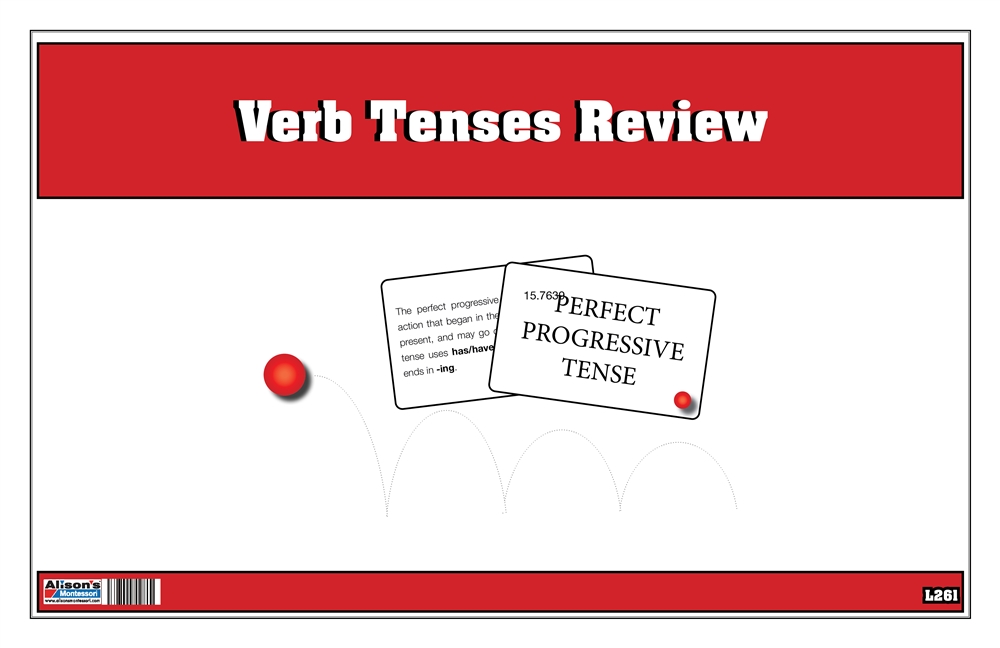 |
| Click to access the information |
EXAM FOCUS 2 DIGITAL INTERACTIVE STUDENT’S BOOK ACCESS CODE
ISBN: 9788420573915
La venta de licencias es a través de la tienda online https://pearson.es/espa%C3%B1a/tiendaonline
LIBRO EN PAPEL (que incluye el contenido digital)
EXAM FOCUS 2 STUDENT'S BOOK PRINT & DIGITAL INTERACTIVE STUDENT'S BOOK ISBN: 9788420573885






